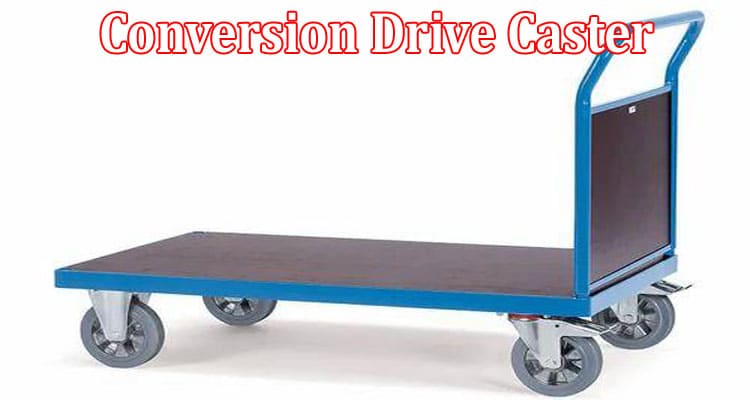Conversion Drive Caster: Why It’s the Best Upgrade for Your Carts
For years, industries have grappled with the limitations of traditional carts. These older models often fail to meet modern demands, from mobility challenges to inefficiencies.
Fortunately, there’s a solution: Conversion Drive Caster. A breakthrough in cart technology, this modern marvel stands poised to revolutionize how industries move heavy loads.
So why not spare some time and closely examine why this drive caster is the best possible upgrade for your carts?
What Will You Learn?
In this article, we’ll introduce you to the innovative technology of motorized drive casters. We’ll highlight its standout features and explain why it’s the upgrade industries have been waiting for.
If you’ve ever wondered how carts could be improved for today’s demands, you’re in the right place. Stay with us and uncover the benefits of Conversion Drive Casters®.
Historical Context: Traditional Carts & Their Limitations
Before we explore the advantages of motorized drive casters, it’s worth taking a quick look at traditional carts. After all, these carts are still used in many industries.
Unfortunately, these conventional models often fail to address current needs – let’s uncover how:
-
Maneuverability Issues – Load and Drive Capacity:
One major limitation of traditional carts surfaces when the load surpasses 2,500 pounds. Beyond this threshold, operating the cart manually becomes a significant challenge. The force needed to initiate movement combines with the constraints of limited space, leading to underutilization of the cart.
Furthermore, narrow pathways became challenging mazes for operators, with every twist and turn an obstacle.
-
Energy and Labor Inefficiencies:
Traditional carts often require considerable manual labor, especially for heavier loads. This requirement not only diminishes productivity in the workspace due to the time and energy consumed but also places an undue burden on the labor force.
These inefficiencies can significantly impact overall performance and output in a workspace where time is critical.
-
Limited Adaptability:
Lastly, traditional carts struggle with long-distance towing and maintaining stability. In addition, their limited load capacity for manual towing hampers operational efficiency, posing yet another challenge for industries.
So, where does the solution lie?
The Solution: Conversion Drive Caster®
Stepping into advanced material handling, we introduce the Conversion Drive Caster® – a symbol of progressive technology.
This marvel isn’t just a caster. It’s a comprehensive unit engineered to breathe new life into your conventional carts. With key components like the drive caster, steering handle, motor controller, and a state-of-the-art battery, it’s poised to redefine cart movement.
Fundamentally, this unit aims to tackle the recurring obstacles encountered when transporting materials from storage to production.
Features to Highlight:
- Two Motor Varieties: Whether you’re looking to move a 3,000 lb. load or double that at 6,000 lbs., there are 1/4 or 1/2 hp motors for you.
- Optional Encoder: This feature gives accurate data on speed and distance, even hinting at automation possibilities.
Specifications Brief:
- Moving Capacity: A robust 5,000 lbs.
- Carrying Limit: A commendable 2,000 lbs.
- Motor Power: A solid 1/2 HP (for 6000 lbs.)
- Max Velocity: A brisk 2 mph.
- Battery: A sturdy 12 Volt / 24 Volt 60 AH.
- Wheel Build: Resilient Polyurethane anchored by a Cast Iron Core.
- Construction & Finish: Steel meets a powder-coated finish, promising durability.
But what sets the Conversion Drive Caster® apart?
It’s the seamless integration. With the ability to move up to a whopping 10,000 lbs with a mere button press, forklifts feel antiquated. This caster isn’t just about movement. It’s about enhancing productivity, ensuring safety, and streamlining operations like never before.
Benefits of Using Motorized Drive Casters in Carts
As we delve into the benefits of motorised drive casters, we must recognize how these innovations are game-changers in the material handling industry.
So, let’s explore some of their advantages!
-
Enhanced Mobility & Maneuverability:
Imagine moving carts effortlessly without the usual push and pull. With the Conversion Drive Caster®, that’s a reality. These casters can manage up to 10,000 lbs.!
And if you’re thinking of speed, you can disconnect the motor and partner it with a tugger for rapid movement. Each caster supports 2,000 pounds, but here’s the magic: for towing, it’s a substantial 5,000 pounds per caster.
Add one more, and you’re doubling the weight. Plus, controlling the cart becomes a breeze.
-
High Efficiency:
Energy conservation is at its peak. Gone are the days of exhausting manual labor. The motorized drive casters ensure zero injury and more productivity. And the best part is that workers don’t need specific training to operate the Drive Cart.
“Workspaces transform into hubs of efficiency.”
-
Durability and Longevity:
Built like a tank, this caster drive is in for the long haul. Whether you’re thinking of dollies or platforms, adding this caster means moving up to 5,000 pounds without a worry. It’s designed for the tough roads ahead.
-
Cost-Effective in the Long Run:
Looking at the bigger picture, it’s all about saving. Be it lesser maintenance, cutting down on manpower, or slashing energy costs – the savings stack up, making it a wise investment for the future.
Case Study: How Our Conversion Drive Caster® Helps YACHT Manufacturer in Navigating Tight Spaces
The Situation:
A premier yacht manufacturer grappled with transporting large carts of dies and castings from their press to the stamping section. This cumbersome process caused significant bottlenecks and heightened the risk of employee injuries. The real challenge was the 90° turn in narrow hallways, without altering the cart’s direction. Various techniques, including multiple personnel and forklifts, proved ineffective, exacerbating the injury risk.
The Solution:
Enter Caster Concepts. After a thorough facility analysis, our team proposed integrating two Conversion Drive Casters® at the carts’ tail ends. This addition transformed the steering dynamics, enabling precise movement by merely two personnel and eliminating the earlier hazards.
The Result?
A drastic cut in injury risk, removal of operational blockades, and a smoother workflow. These state-of-the-art battery-powered casters, designed for loads up to 5,000 pounds, made pushing carts almost effortless, significantly reducing overexertion-related injuries.
Click here to check out this whole case study!
Crane Alternatives: Understanding the Comparative Benefits
Cranes and jacks are all common alternatives to motorized drive casters. But here’s the catch – they don’t offer comparable advantages as far as safety, efficiency, and cost-effectiveness are concerned.
Using cranes and hoists, for instance, involves significant overhead costs in terms of setup and maintenance. Plus, they remain ill-suited for smaller applications due to their limited mobility.
So, why not choose an economical solution that can easily be deployed to your existing carts?
The Conversion Drive Caster® is the logical choice. Not only does it cover all bases, but it also proves to be a worthy investment in terms of cost and productivity.
Conceptual Innovations – Where Engineering Meets Motion Revolution
At Conceptual Innovations, we stand proud as pioneers in crafting the future of motion. As the top-tier manufacturer of motorized drive casters, we’re not just creating products; we’re revolutionizing industries.
Our diverse mobility solutions, including HALODRIVE and DRIVE CASTER, ensure seamless operation and maximum efficiency in various sectors.
Whether it’s our renowned Conversion Drive Caster® or DRIVE CART®, innovation is always at the forefront.
Curious about our game-changing technologies?
Reach out to us today. For a deeper dive, get in touch, and let’s engineer greatness together!`




